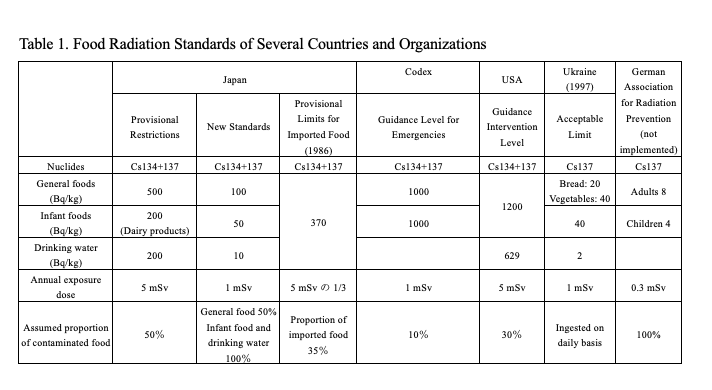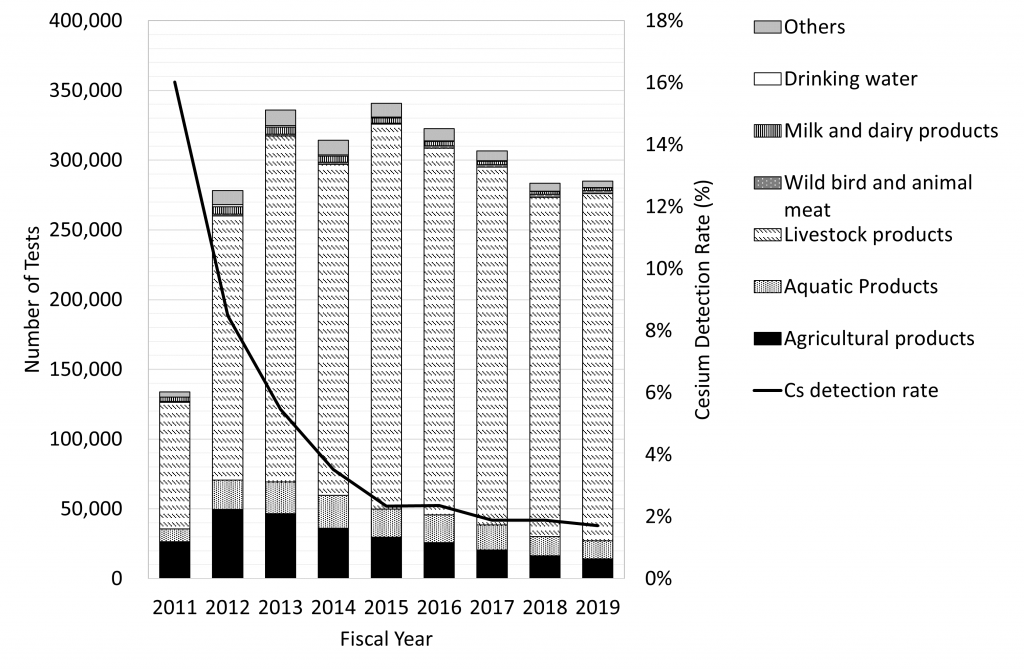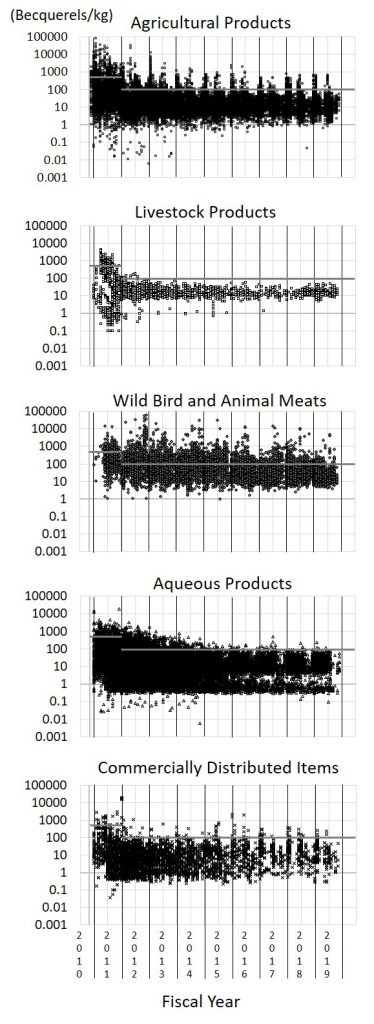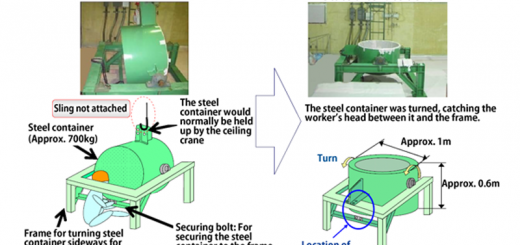Radioactive Cesium Contamination of Food After the Fukushima Nuclear Accident Summary up to Fiscal Year 2019
By Tanimura Nobuko (CNIC staff)
Introduction
Almost ten years have passed since the Tokyo Electric Power Company (TEPCO) Fukushima nuclear accident occurred in March 2011.
Various kinds of foods were contaminated with radioactive substances after the nuclear accident occurred, much of the contamination being discovered to have exceeded the provisional standards for the concentration of radioactive substances. Not only were shipping restrictions placed on food inside Japan, many countries around the world also took measures to ban imports of food from Japan. 54 countries and regions introduced import restrictions on food from Japan after the accident. 35 countries and regions have now rescinded the restrictions, while 19 countries and regions still have restrictions in place to this day (as of September 9, 2020). (English PDF available here)
The radioactive contamination of the environment caused by the Fukushima nuclear accident, assessed as Level 7, the most severe accident level on the International Nuclear and Radiological Event Scale (INES), has attracted strong attention from around the world. This article, for the purpose of grasping an overall picture of the realities of the radioactive contamination of food, summarizes the results of analyses of the long-term trend and regional bias of the concentration of radioactive substances included in food for each food item based on food radiation testing data compiled by the Ministry of Health, Labour and Welfare (MHLW) up to fiscal year (FY)2019. The original data (in English) can be downloaded from the MHLW website here.
Analytical Method
The data were analyzed as follows:
Food item classification was altered from FY2012 from what it had been until the end of FY2011, (vegetables, grains, aqueous products, milk and dairy products, meat and eggs, others, and beef in FY2011 to agricultural products, aqueous products, livestock products, wild animal and bird meat, milk and dairy products, drinking water, and others from FY2012.) To carry out a consistent analysis, the categories of “vegetables” and “grains” up to the end of FY2011 were included in “agricultural products,” pork, chicken and mutton from the category “meat and eggs” up to the end of FY2011 were included in “livestock products,” and other meats thought to derive from wild animals were included in “wild animal and bird meat.” The classification “beef” in FY2011 was included in “livestock products” from FY2012.
The time axis of the analysis takes the sample collection date as the criterion and is summarized in monthly units, such that the data for March 2011 is included in the FY2011 data. The detection limit in the case of “not detected” due to measurement conditions differs from case to case, but only the results that showed a positive detection are plotted.
This analysis only looks at the concentration of radioactive cesium (the total of Cs-134 and Cs-137) contained in food. Radioactive iodine-131 (with a half-life of 8 days) is not detected after four months following the accident. Further, the data for the results of the testing of all bags of rice in Fukushima Prefecture are not included in this data.
Standards for the Concentration of Radioactive Substances Contained in Food
Before looking at the test data, a slightly detailed explanation of standards for radioactive substances in food is given here.
The setting of the standards does not mean that any value below the standards is absolutely safe, but that when internal exposure occurs from ingestion of the food contaminated with radioactive substances, it represents the value the government has determined that is considered to be acceptable for exposure doses.
In the “normal times” (what IAEA terms ‘planned exposure situations’) prior to the nuclear accident, the policy was that exposure doses from artificial radioactive substances (excluding natural radiation and medical exposures) for the general public, as a total of external and internal exposures, should be held to 1mSv/y (milliSieverts per year).
However, in the “time of emergency” (what IAEA terms ‘emergency exposure situation’) after the nuclear accident had occurred, large amounts of radioactive substances were released into the environment, and therefore (the government judged that) there was no option but to ask the general public to accept much higher exposure doses. Thus, on March 17, 2011, immediately after the Fukushima nuclear accident, the government announced “provisional standards” for food. This standard forced the general public to accept an internal exposure from food up to 5mSv/y.
These “provisional standards” were revised to become the “New Radioactive Cesium Standards” about a year after the nuclear accident, in April 2012. Exposure from food was set at up to 1mSv/y (Figure 1). Since external exposure was not taken into account, it can be said that people were being asked to accept a total exposure for both internal and external exposure that exceeded 1mSv/y.
To set food standards, it is necessary to convert exposure dose (in Sieverts) into quantity of radioactive substance (measured in becquerels). This calculation is related to the nuclides (cesium-137, cesium-134, iodine-131, etc.), the amount taken into the body (grams) and sensitivity to exposure (age of person consuming the food). The amount of food is not simply the total amount of food, but must take into account the proportion of contaminated food. Further, the new standards define the abundance ratio of nuclides in the food as cesium-137:strontium-90 = 1:0.003, but it is necessary to point out that in reality almost no measurement of nuclides other than radioactive cesium is being currently carried out.
The cesium-137 standards of a number of organizations and countries are compared in Table 1.
In the case of Japan’s “provisional standards,” at an assumed contamination rate of 50%, the exposure dose limit was set at 5mSv/y from food. Under the “new standards,” at an assumed contamination rate of 50% for general foodstuffs (100% for infant food) the exposure dose limit was set at 1mSv/y.
Looking carefully at the limits for the concentration of radioactive substances (Bq/kg – becquerels per kilogram), it appears that Codex and the USA recognize high contamination levels. However, Codex assumes the low value of 10% for the proportion of contaminated food. This is an estimate of the proportion of contaminated food imported into a region from another country where a nuclear accident has occurred, i.e. in an emergency situation. The USA also assumes an emergency situation, the exposure dose being 5mSv/y on the premise of a contamination co-mingling ratio of 30%.
Nuclear power proponents simply compare the becquerel concentrations, insisting that “Japan has the most stringent food standard levels in the world,” but this is mistaken.
At the same time, Ukraine strictly limits radioactive substance concentrations at a relatively low level, but it is thought that this is because their territory was widely contaminated with radioactive substances due to the Chernobyl nuclear accident, and therefore the risk of ingesting contaminated food on a daily basis is high.
Further, based on the proposed (but not implemented) values of the German Association for Radiation Prevention (Gesellschaft für Strahlenschutz, GS), if annual exposure doses to the general public from nuclear facilities are set to not exceed 0.3mSv, the calculated value infers that this cannot be achieved unless food contamination is also strictly limited to this value.
Testing System
Testing for radioactive substances in food is carried out mainly by municipalities, who formulate plans and implement the testing. Items to be tested are those that are more susceptible to contamination and those for which the municipality is a well-known producer, based on previous knowledge and experience. If newly contaminated foods are discovered, test numbers increase in that area and for those items. Following that, in the case of agricultural products, etc., contamination prevention countermeasures are taken. If these are recognized as effective, the testing frequency falls, resulting in test number fluctuations.
Let us look at the trend in food radiation test numbers (Figure 2). Roughly 130,000 tests were performed from the Fukushima nuclear accident up to the end of FY2011. Along with the expansion and upgrading of the testing system, this increased to around 280,000 tests performed in FY2012, and around 340,000 in FY2013. With FY2015 as the peak, the scale of testing declined and around 280,000 tests were conducted in FY2019.
Fig. 2: Annual Tend and Breakdown of Numbers of Food Radiation Tests
Looking at the breakdown of test numbers, livestock products accounted for a large proportion of the tests, these fluctuating little after FY2013 at roughly an annual 240,000 to 260,000 tests. In contrast, test numbers for agricultural products were 27,000 in the first year, increased to around 50,000 two years later, thereafter declining each year to reach roughly 14,000 tests in FY2019.
The next most numerous tests were for aqueous products. In FY2011, 9,000 tests were performed. following which the numbers of tests rose each year to reach a maximum of around 24,000 in FY2014. After this, the numbers began to fall until they reached approximately 13,000 in FY2019.
Against this huge number of tests, the proportion in which even a small amount of radioactive cesium was detected was 16% in FY2011, 8% in FY2012, falling to around 2% in FY2015 and around 2% again in FY2019.
Trends in Cesium Concentration by Food Category
Figure 3 shows plots of cesium (Cs-134+Cs-137) concentration (no plots in undetectable cases) against a time axis for each of agricultural products, aqueous products, livestock products, wild bird and animal meat and commercially distributed items. The vertical axis is on a logarithmic scale, the minimum being 0.001 Bq/kg and the maximum being 100,000 Bq/kg, all graphs being adjusted to use the same scale. Overall, it can be seen quite plainly that the behavior of the cesium concentration differs for each food category.
Agricultural Products
Immediately after the accident, spinach, broccoli, parsley, shiitake mushrooms, bamboo shoots, etc. in Fukushima Prefecture and the North Kanto Plain area were discovered to be highly contaminated with a radioactive cesium concentration of 10,000 Bq/kg to 100,000 Bq/kg.
Moreover, tea leaves (on the plant before picking) were contaminated in Shizuoka Prefecture, all of 300km from Fukushima Prefecture. In June 2011, tea contaminated with radioactive cesium to the extent of 1038 Bq/kg, exceeding the EU standard of 500 Bq/kg, was detected in the importing country, France, sending shockwaves through the industry. At the beginning of that month, Ibaraki, Kanagawa, Chiba and Tochigi Prefectures were designated as tea leaf shipping-restricted areas and, in fact, the exports had gone ahead because testing carried out by Shizuoka Prefecture authorities had not discovered tea leaves that exceeded the standard up to that point.
A characteristic of the trend in concentrations of radioactive cesium in agricultural products is that it can be seen that products exceeded the standard in a cyclic manner. These cyclic peaks coincide with the harvesting of spring wild vegetables and autumn mushrooms. The maximum concentrations are around 1000 Bq/kg and appear to decline only very slowly over time. From FY2013 onwards, with the exception of wild vegetables and mushrooms, almost no items exceeded the 100 Bq/kg of the “new standards.”
Livestock
The characteristic of livestock is that there have been a very large number of tests. Of the total of roughly 285,000 tests in FY2019, 249,000 were tests involving livestock products; 87% of the total number of tests. At the same time, the proportion in which any radioactive cesium was detected is low. In tests carried out in FY2011, the proportion in which even a small amount of radioactive cesium was detected was around 9%, which fell to 0.3% in FY2012, thereafter stabilizing at around 0.1%. Currently, no tests show that the standard has been exceeded. It can be said that livestock farming management that prevents radioactive contamination is being implemented. However, the detection limit is relatively high, at 25 Bq/kg.
From July to December 2011, large amounts of beef containing radioactive cesium at a level of 500 Bq/kg to 5,000 Bq/kg were discovered in Fukushima, Iwate, Miyagi and Tochigi Prefectures. The cause was that rice straw contaminated with radioactive substances had been fed to the cattle, the contaminated beef then being distributed nationwide. The rice straw contamination was not only due to livestock farmers growing and consuming their own rice, but also the result of the distribution of rice straw containing radioactive substances grown in the northeast Japan and Kanto areas being distributed to uncontaminated regions, this becoming a problem on a nationwide scale.
Consumers’ willingness to buy dropped sharply, the amounts of beef sold falling to 67% compared with the previous year. To regain the trust of consumers, a movement to implement “total head testing” spread among related municipalities. It is thought that this is the background to radiation test numbers for livestock still being notably higher than for other items even today.
Wild bird and animal meat
At present, the highest concentrations of radioactive cesium are being detected in wild meats. These concentrations are approximately 10,000 Bq/kg and are declining only very slowly despite the fact that almost ten years have passed since the nuclear accident. Wild animals in which radioactive contamination has been confirmed include wild boars, bears, deer, hares, copper pheasants and ducks.
Further, at present in Japan, it is not usual to consume wild bird and animal meat on a daily basis, and these meats are generally consumed when enjoying special occasions such as country cuisine in mountainous areas. Annual consumed amounts total roughly 1,400 tons, which is clearly a very small amount when compared with beef at 470,000 tons, and pork at 1,280,000 tons.
Wild boar contamination is especially severe. Wild boars are omnivorous, eating mushrooms in spring, hard fruits (such as chestnuts) and animal foods in autumn, and roots and stems in winter. It is well known that mushrooms and chestnuts easily absorb radioactive cesium, and as contaminated soil is ingested when eating roots, it is thought that the wild boar ecology inherently leads to the ingestion of large amounts of radioactive cesium.
It is considered that wild boar contamination is a rule of thumb for estimating the degree of contamination of mountain areas that are wild boar habitats. An analysis of wild boar habitats in which radioactive contamination of wild boars has been confirmed is shown in Figure 4. The figure suggests that severe and ongoing contamination is present in forested mountain areas not only in Fukushima Prefecture but also in Tochigi, Gunma, Miyagi and Ibaraki Prefectures. Ten years have now passed since the nuclear accident, but with the exception of a few model decontaminated areas, decontamination of forested mountain areas is hardly progressing at all.
Fig. 4: Radioactive Cesium Concentration in Wild Boars by Habitat (FY2019)
Aqueous products
Fisheries of Fukushima Prefecture had little option but to exercise self-restraint in fishing due to the impact of the nuclear accident. At present, as “experimental operations,” small-scale fishing and sales are being conducted, with basic data being gathered in the move toward a full resumption of commercial fishing.
The radioactive cesium concentration of aqueous products has shown an overall gradual decline. Fish known to have a tendency for high radioactive cesium concentrations have been singled out and classified as sea surface fish (such as anchovies and whitebait), seabed fish (such as flounders, e.g. marbled flounder and stone flounder), and freshwater fish (such as landlocked salmon, char and sweetfish), the data for these being shown as a graph in Figure 5. Sea surface fish, represented by ◆ in the figure, were contaminated at a high concentration of 14,000 Bq/kg immediately after the accident, but this concentration fell rapidly until, six months later, no fish were discovered that exceeded the provisional standard of the time. One year after the accident, no fish exceeding 100 Bq/kg were found. A maximum of 4,500 Bq/kg was detected in Seabed fish (represented by □ in the graph) in the autumn of 2011, but this had fallen to below 500 Bq/kg by around the summer of 2013, and in FT2019 had dropped to less than 1Bq/kg.
The concentrations of radioactive cesium in freshwater fish, represented by × in the graph, have shown a tendency not to decline, and even to the present day. Fish exceeding the standards are frequently discovered. It is thought that the reason why there are no test results showing a low concentration is that the detection limit is high, at around 15 Bq/kg.
Fig. 5: Trends in Radioactive Cesium Concentration in Aqueous Products
Commercially distributed items
From the commercially distributed items graph, it is clear that there have still been several foods exceeding the standards in circulation in recent years. In the immediate aftermath of the accident, commercially produced tea, vegetables and fish that exceeded the standards were being distributed, but from FY2013 onwards, the distribution of items exceeding the standards was almost completely limited to wild vegetables and mushrooms, and wild meats.
It has been confirmed that wild vegetables and mushrooms that exceeded the contamination standard were being sold at local agricultural products stores, and it has also been reported in the media that these goods were also being distributed through person-to-person trade using the Internet. As wild vegetables and mushrooms easily take up radioactive substances, shipping restrictions have been imposed over broad areas, but it is thought that people have not gained an accurate grasp of this information.
The records regarding typical commercially distributed foods confirmed as being contaminated with radiation below the standards are indicated as follows. In FY2019, natural Japanese sea bass landed at Choshi port (13 Bq/kg), Fukushima Prefecture honey (13 Bq/kg), Ibaraki Prefecture dried sweet potatoes (8 Bq/kg), etc. In FY2018, natural Japanese sea bass landed at Choshi port (28 Bq/kg), Fukushima Prefecture sliced rice cakes (21 Bq/kg), Fukushima Prefecture pickled plums (18 Bq/kg), Ibaraki Prefecture lotus roots (14 Bq/kg), etc. It is possible that items containing this degree of concentration of radioactive cesium have been ingested during the daily lives of residents in the local areas.
Conclusion
We are now approaching the ten-year mark after the occurrence of the accident. As a result of the accumulation of radioactive food test data over ten years, it has become possible to identify local areas and food items for which care needs to be exercised. Foods from which especially high concentrations of radiation are currently being detected are biased toward wild mushrooms and wild vegetables, wild meats, and freshwater fish. Very broadly speaking, in foods for which the cultivation or raising environment can be controlled, contamination exceeding the standards has now disappeared, but the radioactive contamination of wild foods cannot be controlled.
Food contamination is taken up by the media only when contamination exceeding the standards is discovered. In reality, however, food contaminated by radiation above the detection limit but below the standards exists in large amounts. It is clear that once an environment has been contaminated by a nuclear accident it is impossible to return it to its former state.






